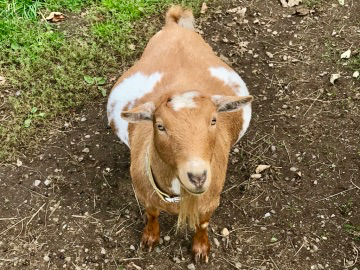
What COLOR is my Goat?
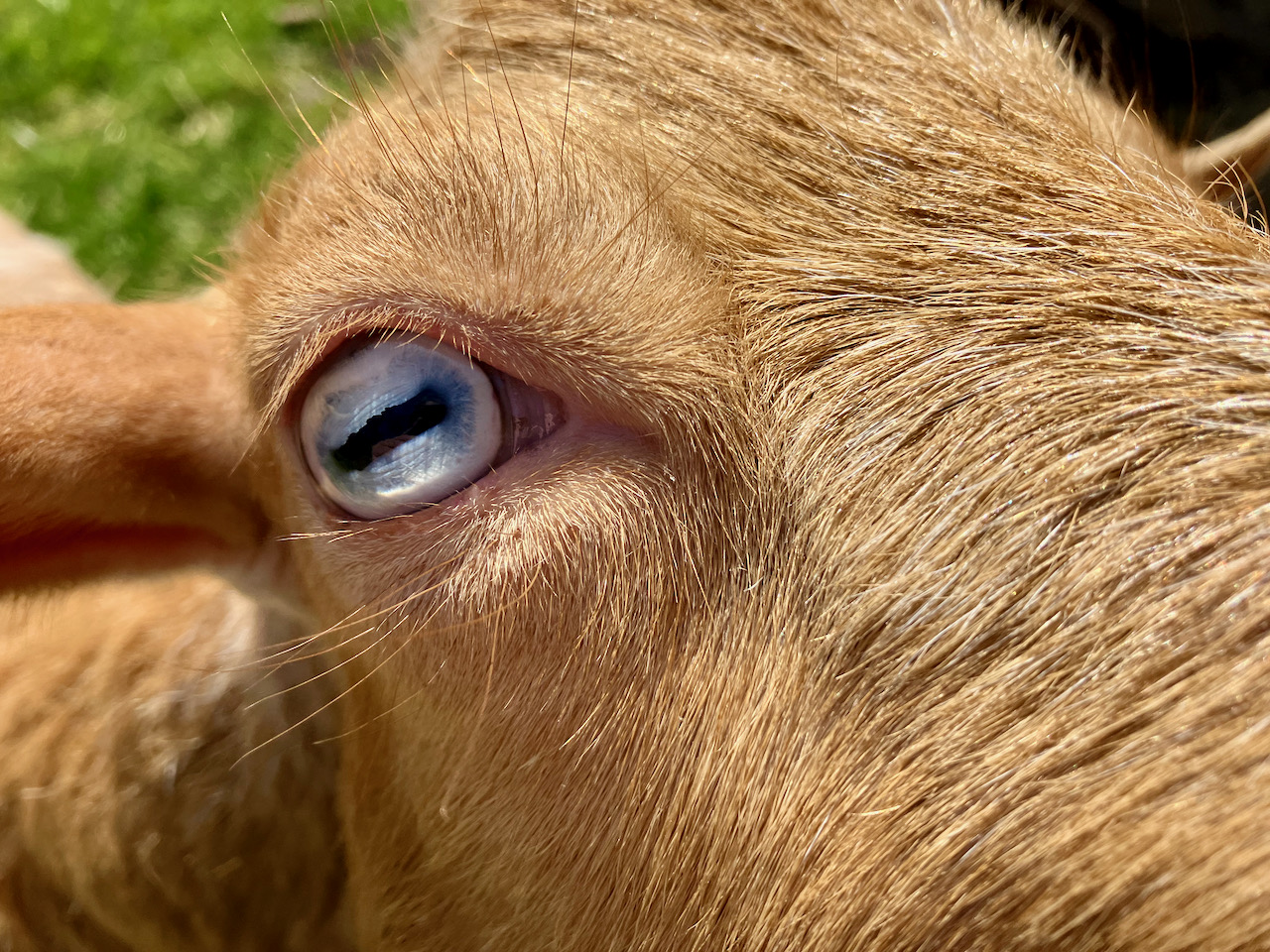
There are 14+ color patterns (Agouti) for goats. In all mammals, the pigments in hair and
skin are made of the protein melanin. Melanin comes in two types. In Goats, Phaeomelanin is
responsible for tan, cream, yellow, red and reddish-brown colors. Eumelanin is responsible
for black, blue-gray and chocolate brown colors. Various genes control how much of each type
of pigment is made and where it is deposited.
Each goat carries two different color patterns one from each parent. One pattern you see,
dominant. One is not visible or not dominant over the one that is showing. Sometimes
patterns can be a mix making is hard to determine what patterns a goat has. A goat’s colors
can change as they mature. The color (not the pattern) they have when born can morph into
something else. For us this seems to be the most dramatic with the kids who have Roaning or
the Brown Gene.
The Gold Pattern is always dominant over all other patterns & Black (No Pattern) is always
recessive. All the patterns in between can fluctuate a bit. We currently only have Gold,
Chamoisee, Buckskin, Swiss Marked, Light Belly and Black on our farm. Knowing a goat’s
patterns can help us approximate what pattern & color the kids will be. Color unfortunately
has no bearing on milk production or friendliness. We breed for improved conformation & milk
production. Below are descriptions & pictures of the patterns we have on the farm to keep it
simple. They are listed in approximate order of dominance.
They are solid white, cream, tan, gold, red colored with no black pattern. They may have some “shadow markings” of somewhat darker color on face, shoulders and legs. This is the most dominant pattern; it trumps all others. If a goat has this color pattern it will always show. We usually have a lot of Gold Kids!

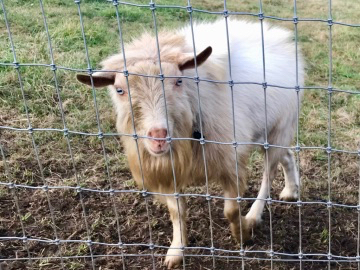
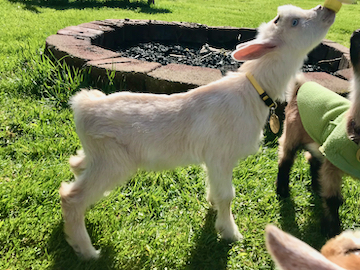
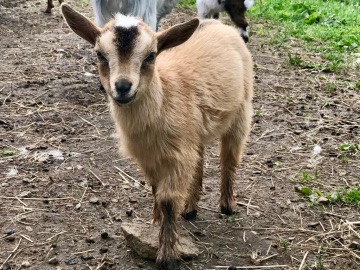
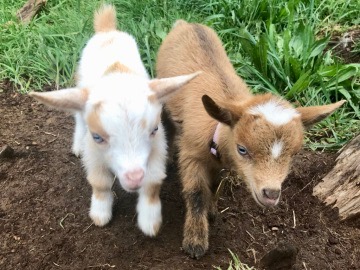
Tan with black belly, back stripe, lower legs and face. The Brown Gene will dilute all black areas of the pattern to chocolate brown.
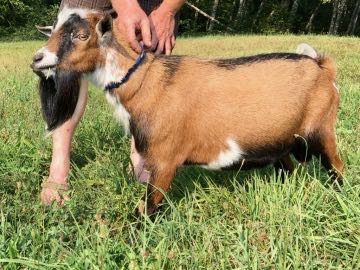
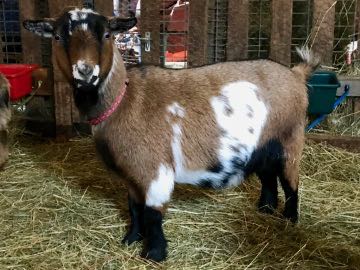
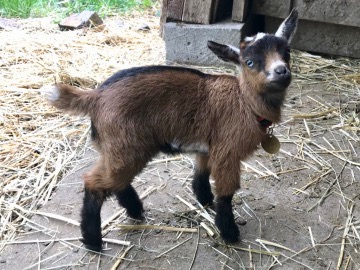
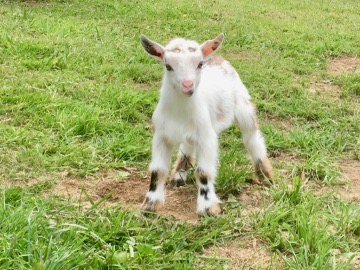
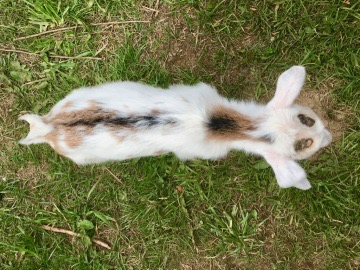
Black front half, tan rear half, light stripes on dark head, pale legs. In the Nigerian, can be very variable in how far back the black extends, but the black chevron on the rear legs is distinctive. The tan areas can be any shade, Cream to Gold. The Brown Gene will dilute all black areas of the pattern to chocolate brown.
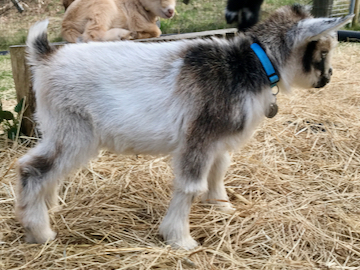
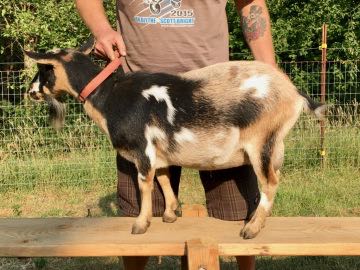
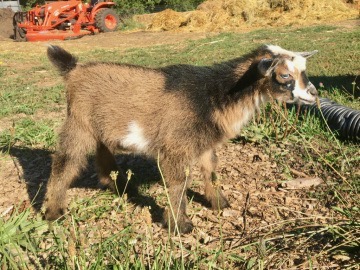
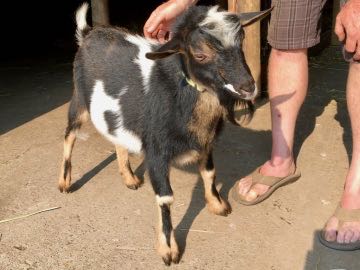
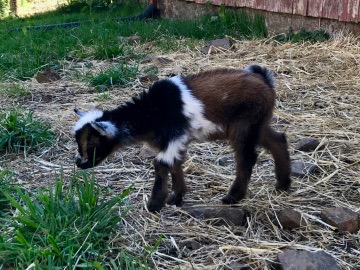
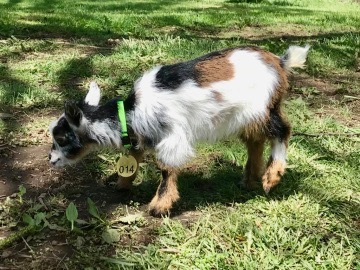
Dark body, dark belly, pale legs, ears and facial stripes. This is one of our favorite patterns. Brown versions of Swiss Marked are called Toggenburg.
Black & Tan and Sundgau are dark with light belly, striped legs, light inside ears and facial stripes. Striped Light Belly & Light Eyebar have facial striping like the Swiss marked pattern. Sundgau have white markings instead of tan. Similar to the markings of a Doberman pinscher.
Solid Black, this is a Recessive Pattern. Both the Visible & Hidden Patterns must be Black to express solid black. Solid Brown goats are genetically Black. We currently have 3 Black does & 5 does are confirmed to carry Black. Three of my bucks also carry Black, so we should always have a few Black kids.
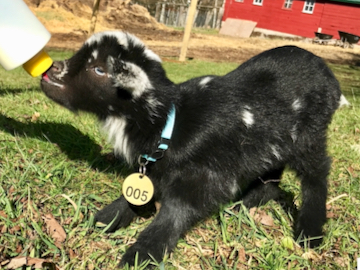
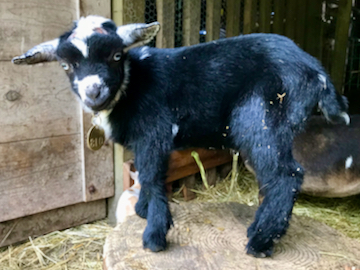
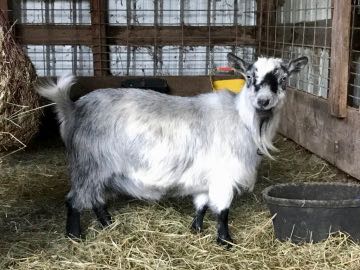
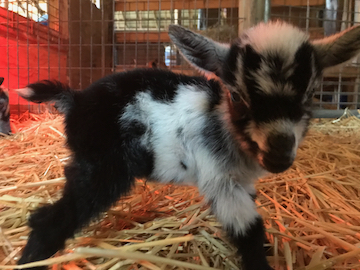
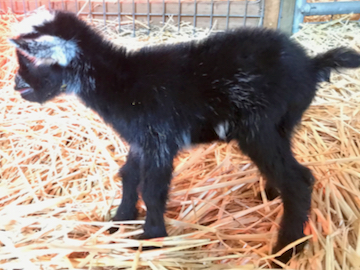
Kastor is a combo of Chamoisee & Buckskin. Her sire is Chamoise/Black. Her dam is Buckskin/Black? Chamoisee does not always trump Buckskin, often a combination of the two expresses. When this occurs, all Tan parts of both patterns express. She does have a strange non-roan darker spot on one side that seem like it wanted to be a broken belt, it's been there since birth. Well we gave Kastor a show clip for 2021 LA's and that non-roaned spot is actually big a moonspot. She has several other too. They are not visible without a clip. Her sire has moonspots. Would love to breed her to a black buck to see exactly what she produces.
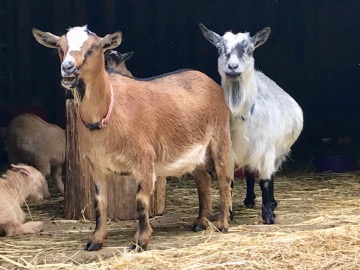


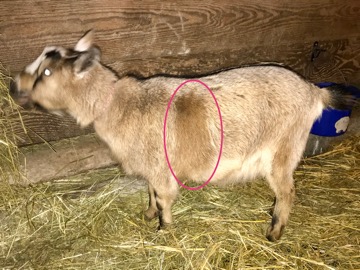

Stetson & his sister, Sagebrush are almost identical twins! they are a stunning combination of the Chamoisee & Swiss patterns. They are roan to boot! This might just be my new favorite pattern. They are a light grey-brown roaned Chamoisee with white legs, muzzles & face striping.
The Brown Gene is not a pattern but produces Dark Chocolate Brown (Bd), Light Brown/Milk
Chocolate (Bl) or Liver Red (b) pigment in areas that would otherwise be Black (B+). Chocolate &
Light Brown are dominant, and a goat only needs 1 copy for it to show. Liver Red is recessive
and needs 2 copies to show. It is very rare. Chocolate-Brown (Bd), Light Brown (Bl) or Liver Red
will not be visible on the Gold (No Black) Pattern, but gold goats may pass it on to its
offspring.
I have 2 does with the brown gene. I have found the Brown Gene is vexing when
comes time to register young kids. Some brown kids are born black, which genetically they are,
and then lighten to brown. Most of my brown kids are born looking like a combination of
patterns. These kids slowly lighten & darken brown by 3-5 months.
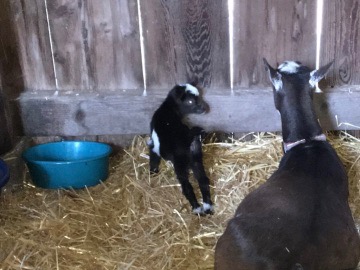
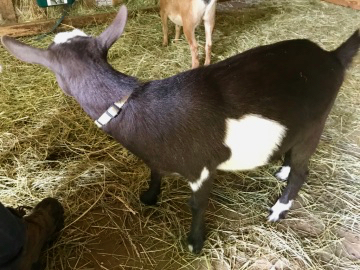
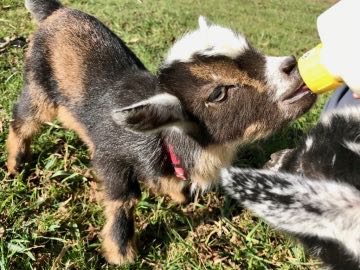
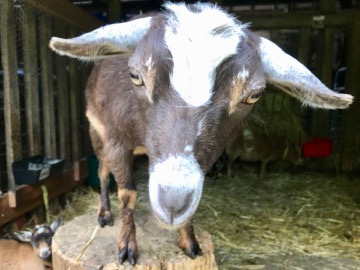
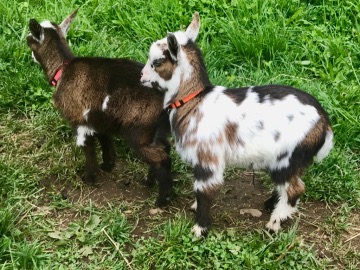
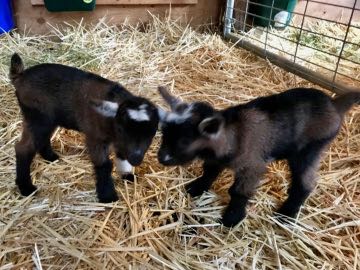
White spotting is produced by entirely different genetic mechanisms than color patterns. In
addition, there are a large number of poorly defined genes responsible for spotting, and
little is known with certainty about their modes of inheritance. A goat can possess several
different spotting patterns, and a goat of any color or pattern can display spotting.
Spotting also acts to mask a goat's apparent color pattern. It can sometimes be difficult to
discern what the goat's pattern would be without the white spots! We call these goats
Abundant White. Seems like in our herd both parents need to be Belted & have Random White to
produce an Abundant White kid. Belted is thought to be dominant & Random White is thought to
be recessive.
Examples of some White Patterns are below along with descriptions.

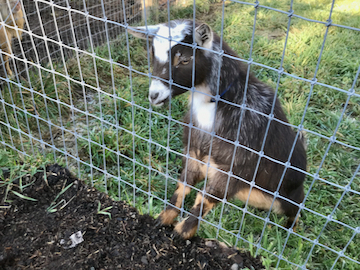

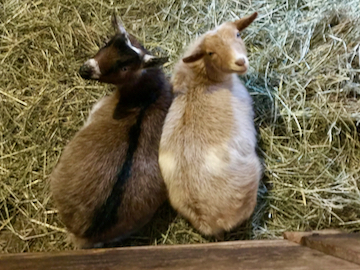

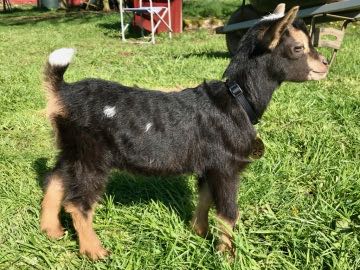
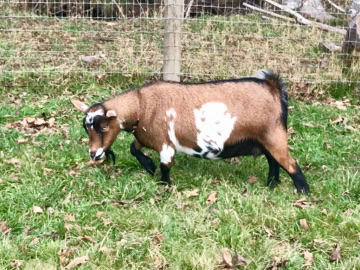
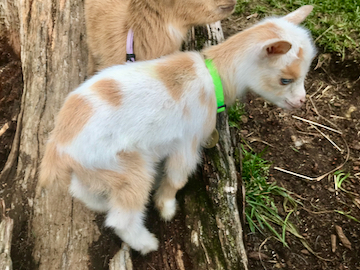
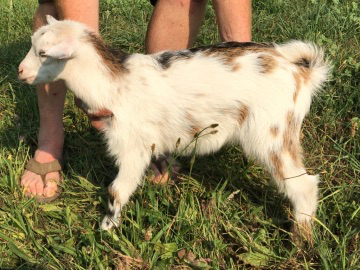
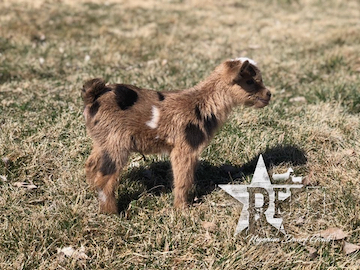
This varies from a nice ring around the barrel of the goat to a nearly white goat with colored tail and head. Also includes some with single side spots, as these are incomplete belts. Partial or Broken Belts can apparently also be caused by modifier genes, as they can revert to Full Belts in the next generation. It is likely dominant.
Can vary from one tiny spot to complete covering. The spotted type is more random than the belted and is sometimes difficult to distinguish from belting. Spotted goats usually have white on the legs and head, and patches of white and color on the body. The typical spots of this pattern are smooth edged and round. Minimally spotted and minimally belted animals can be very similar, although usually “spotted” involves the head and feet.
This gene causes a scattering of white hairs in the coat color. This gene probably shows some degree of co-dominance with RnRn goats having more white than Rnrn ones. Often the amount of roaning (white) is less over the head and shoulders. Roans either have a stable pattern or grow lighter.
White on the muzzle and ears. It is dominant. Most Nigerian Goats have frosted ears. It is noteworthy if they don't.
White on the muzzle and ears. Often accompanied by a White Tipped Tail. It is dominant. It is very common in Nigerian Goats.
This is a pattern of small white flecks throughout the coat. They are especially prominent on the sides and belly. Varies from a few flecks on belly to a very pale roan flecked goat. It is probably dominant.
A goat will have small colored spots in otherwise-white areas. One can think of it as opposite of Flowery, holes in the white the let the goats color pattern show. It is thought to be dominant.
Moonspots are those interesting dark brown to cream (but never true white or black) round spots that can be superimposed over any other color or pattern. Moonspots often change color, lightening as the goat ages. The gene is considered dominant. A moon spot can be as tiny as just a few hairs and can also be "hidden" by white markings. Most moonspots are fairly dark in newborns, and then become distinctly paler later. This is so pronounced that they could be missed on some kids, even though they might be very obvious later. We have found Moonspots on our Brown Goats once we have given them a show clip. We have 2 does that never showed any signs of having moonspots, they do share a sire who has them. Once clipped for Linear Appraisals, if was very obvious they had moonspots. On the brown doe, Lola, her spots are dark brown and her coat cliped is light brown.
Below is a chart of our kid's color possibilities. Bucks are listed across the top & Does down the left side. Each Buck & Doe has the following listed: Name, ADGA Linear Score (if available), Color Patterns, Brown Gene, White Patterns, Eye Color. We do not list the kids possible White Patterns as there are just too many variables. We do list if the match as previously produced Abundant White kids.
| REBEL ACRES CC RED RYDER *B FS84 (+VV ) @ 02-02
|
REBEL ACRES SP TANQUERAY *B Swiss/Black
|
GARDENVIEWFARMS CC RAPHAEL *B Buckskin/Black
|
BREWFM RUMPELSTILTSKIN Gold/Swiss or Black
|
|
| BREWFM KASTOR FS84 (+VV+) @ 03-00 Chamoisee/Buckskin
|
Gold 50% |
Chamoisee 50%
|
Chamoisee 50%
|
Paternal Niece / Uncle |
| BREWFM LOLA FS83 (++++) @ 02-03 Light Belly/Black
|
Gold 50%
|
Swiss 37.5%
|
Buckskin 37.5%
| Paternal Niece / Uncle |
BREWFM NIAMHChamoisee/Black
|
Daughter/Father |
Chamoisee 37.5%
|
Chamoisee 37.5%
|
Maternal Sister / Brother |
BREWFM ROSA BELLAChamoisee/Black
|
Daughter/Father |
Chamoisee 37.5%
|
Gold 37.5%
|
Gold 37.5%
|
BREWFM RAINBOWGold/Swiss or Black
|
GreatGranddaughter
|
Daughter/Father |
Chamoisee 37.5%
|
Paternal Sibling |
BREWFM RP SAOIRSEBuckskin or Chamoisee/Black
|
Granddaughter/Granddad |
Buckskin, Chamoisee, Swiss & Black Possible
|
Daughter/Father |
Maternal Niece/Uncle |
BREWFM RP SELENEBlack/Black
|
/GreatGranddad |
Swiss 50%
|
Daughter/Father |
Gold 37.5%%
|
BREWFM TQ SAPPHIREBlack/Black
|
|
Daughter/Father |
Buckskin 50%
|
Paternal Sister/Brother |
BREWFM RR SARSAPARILLAGold / Swiss or Black
|
Daughter/Father |
Granddaughter/Grandpa |
Gold 37.5%
|
Paternal
|
| BREWFM RS STELLA BELLA Gold/Black
|
Gold 50%
|
Granddaughter/Grandpa |
Gold 37.5%
|
Daughter/Father |
BREWFM TQ SPRINKLESLight Belly / Swiss or Black
|
Gold 50%
|
Daughter/Father |
Buckskin 37.5%
|
Paternal Neice/Uncle |